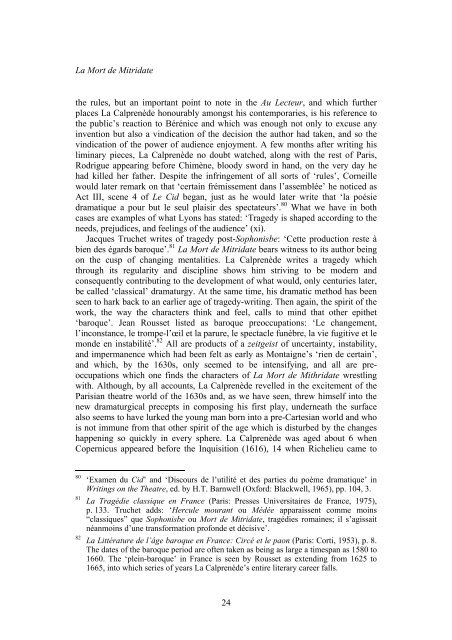LA MORT DE MITRIDATE - University of Liverpool
LA MORT DE MITRIDATE - University of Liverpool
LA MORT DE MITRIDATE - University of Liverpool
You also want an ePaper? Increase the reach of your titles
YUMPU automatically turns print PDFs into web optimized ePapers that Google loves.
La Mort de Mitridate<br />
the rules, but an important point to note in the Au Lecteur, and which further<br />
places La Calprenède honourably amongst his contemporaries, is his reference to<br />
the public’s reaction to Bérénice and which was enough not only to excuse any<br />
invention but also a vindication <strong>of</strong> the decision the author had taken, and so the<br />
vindication <strong>of</strong> the power <strong>of</strong> audience enjoyment. A few months after writing his<br />
liminary pieces, La Calprenède no doubt watched, along with the rest <strong>of</strong> Paris,<br />
Rodrigue appearing before Chimène, bloody sword in hand, on the very day he<br />
had killed her father. Despite the infringement <strong>of</strong> all sorts <strong>of</strong> ‘rules’, Corneille<br />
would later remark on that ‘certain frémissement dans l’assemblée’ he noticed as<br />
Act III, scene 4 <strong>of</strong> Le Cid began, just as he would later write that ‘la poésie<br />
dramatique a pour but le seul plaisir des spectateurs’. 80 What we have in both<br />
cases are examples <strong>of</strong> what Lyons has stated: ‘Tragedy is shaped according to the<br />
needs, prejudices, and feelings <strong>of</strong> the audience’ (xi).<br />
Jacques Truchet writes <strong>of</strong> tragedy post-Sophonisbe: ‘Cette production reste à<br />
bien des égards baroque’. 81 La Mort de Mitridate bears witness to its author being<br />
on the cusp <strong>of</strong> changing mentalities. La Calprenède writes a tragedy which<br />
through its regularity and discipline shows him striving to be modern and<br />
consequently contributing to the development <strong>of</strong> what would, only centuries later,<br />
be called ‘classical’ dramaturgy. At the same time, his dramatic method has been<br />
seen to hark back to an earlier age <strong>of</strong> tragedy-writing. Then again, the spirit <strong>of</strong> the<br />
work, the way the characters think and feel, calls to mind that other epithet<br />
‘baroque’. Jean Rousset listed as baroque preoccupations: ‘Le changement,<br />
l’inconstance, le trompe-l’œil et la parure, le spectacle funèbre, la vie fugitive et le<br />
monde en instabilité’. 82 All are products <strong>of</strong> a zeitgeist <strong>of</strong> uncertainty, instability,<br />
and impermanence which had been felt as early as Montaigne’s ‘rien de certain’,<br />
and which, by the 1630s, only seemed to be intensifying, and all are preoccupations<br />
which one finds the characters <strong>of</strong> La Mort de Mithridate wrestling<br />
with. Although, by all accounts, La Calprenède revelled in the excitement <strong>of</strong> the<br />
Parisian theatre world <strong>of</strong> the 1630s and, as we have seen, threw himself into the<br />
new dramaturgical precepts in composing his first play, underneath the surface<br />
also seems to have lurked the young man born into a pre-Cartesian world and who<br />
is not immune from that other spirit <strong>of</strong> the age which is disturbed by the changes<br />
happening so quickly in every sphere. La Calprenède was aged about 6 when<br />
Copernicus appeared before the Inquisition (1616), 14 when Richelieu came to<br />
80 ‘Examen du Cid’ and ‘Discours de l’utilité et des parties du poème dramatique’ in<br />
Writings on the Theatre, ed. by H.T. Barnwell (Oxford: Blackwell, 1965), pp. 104, 3.<br />
81 La Tragédie classique en France (Paris: Presses Universitaires de France, 1975),<br />
p. 133. Truchet adds: ‘Hercule mourant ou Médée apparaissent comme moins<br />
“classiques” que Sophonisbe ou Mort de Mitridate, tragédies romaines; il s’agissait<br />
néanmoins d’une transformation pr<strong>of</strong>onde et décisive’.<br />
82 La Littérature de l’âge baroque en France: Circé et le paon (Paris: Corti, 1953), p. 8.<br />
The dates <strong>of</strong> the baroque period are <strong>of</strong>ten taken as being as large a timespan as 1580 to<br />
1660. The ‘plein-baroque’ in France is seen by Rousset as extending from 1625 to<br />
1665, into which series <strong>of</strong> years La Calprenède’s entire literary career falls.<br />
24

















